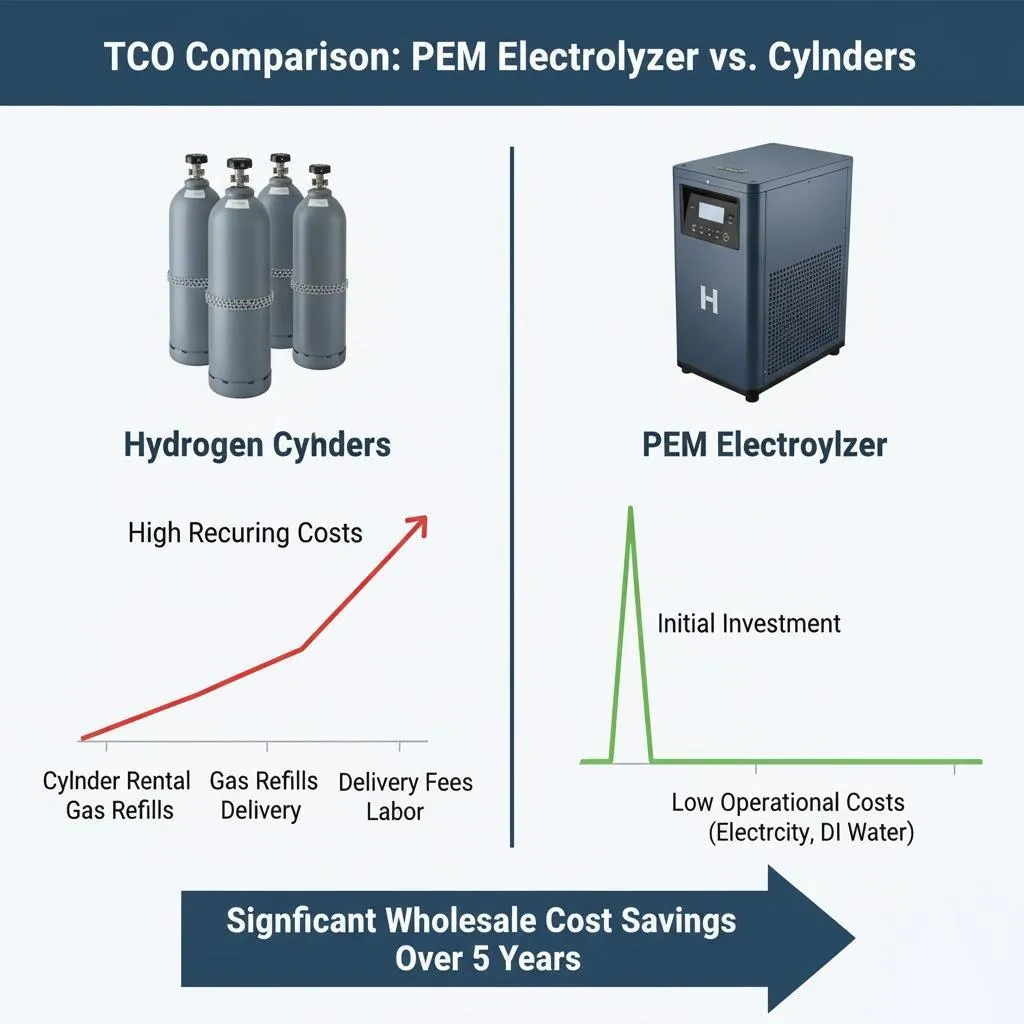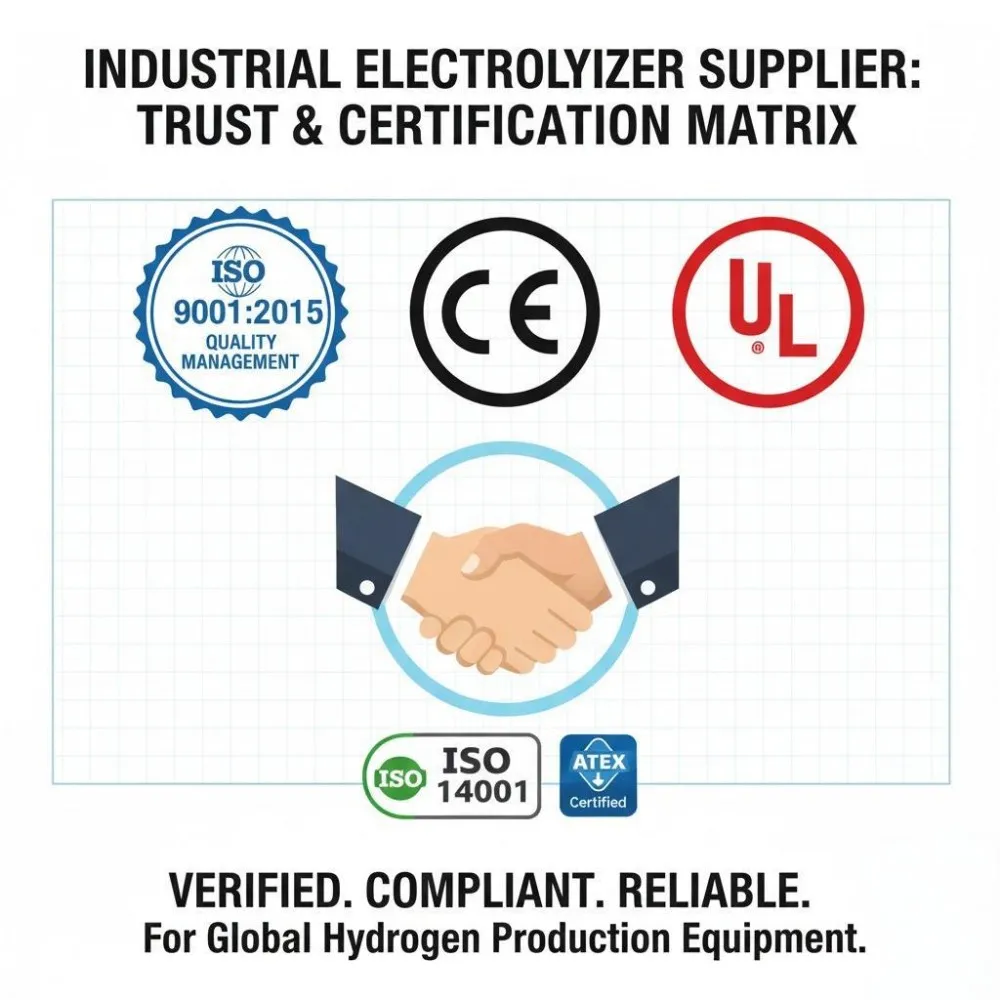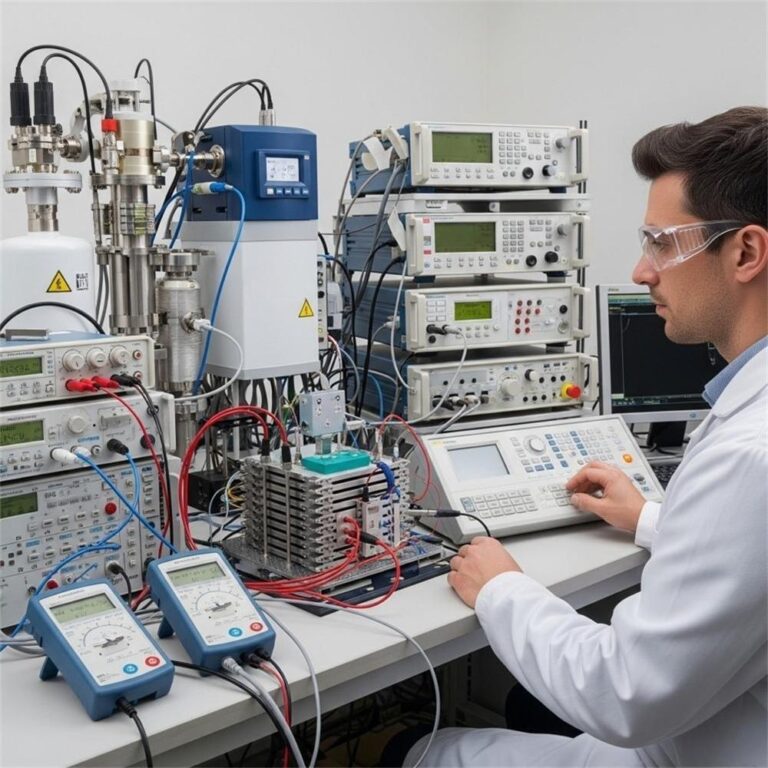Is a Home Hydrogen Electrolyzer System the Right Choice for Your Energy Future? [An Engineer’s Guide]
Author: John Carter, Senior Hydrogen Systems Engineer at Hele Titanium Hydrogen. Author Bio: With over 15 years of experience in PEM electrolysis technology, John Carter helps clients design and implement robust, clean energy solutions. At Hele Hydrogen, we specialize in manufacturing high-purity, high-efficiency PEM hydrogen generators for a sustainable future. Our expertise is in creating systems that offer true energy independence and security.
I. Introduction: The Next Frontier of Home Energy
Your solar panels are a fantastic first step, generating abundant clean power when the sun shines. But what happens at 5 PM when your family returns home, demand peaks, and solar generation wanes? What about that stretch of cloudy winter days or the inevitable grid failure during a storm? You rely on an expensive, degrading battery for a few hours of backup, or worse, fall back on the fossil-fuel-powered grid.
Imagine a better way. Imagine storing that abundant midday solar energy not for hours, but for weeks or even months. Imagine storing it not in a chemical battery, but as a clean, stable, and incredibly energy-dense fuel: green hydrogen.
This isn’t science fiction; it’s the reality of a home hydrogen electrolyzer system. This technology serves as the missing link for achieving 24/7 energy independence, converting your excess renewable power into a storable asset that can power your home, heat your water, and even fuel your vehicle, all with zero emissions.
As a leading manufacturer of advanced PEM (Proton Exchange Membrane) electrolyzers, we at Hele Titanium Hydrogen are on the front lines of this energy revolution. This guide, drawing from our team’s deep engineering expertise, will provide a transparent, comprehensive look at the technology. We’ll explore the benefits, realistic costs, and crucial steps for integrating a PEM electrolyzer into your home, helping you make an informed and confident investment in your energy future.
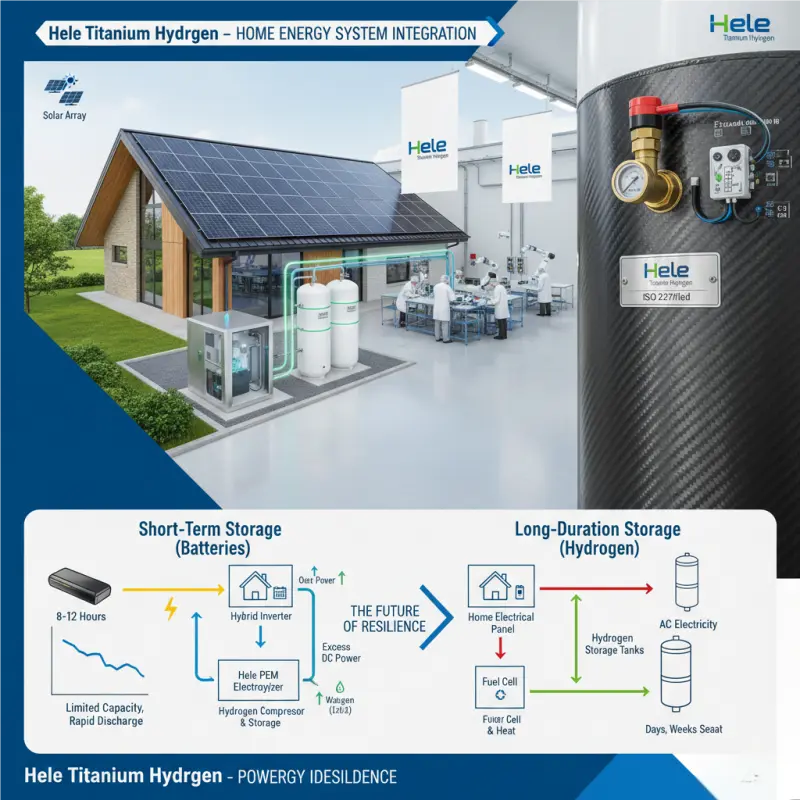
II. How a Home Hydrogen Energy Cycle Works
At its core, a home hydrogen system is an elegant energy cycle. It allows you to capture, store, and deploy renewable energy with remarkable flexibility. Let’s break down how this technology works.
The Core Process: Water Electrolysis
The fundamental process is called electrolysis—a concept you might remember from chemistry class, but now perfected for home energy applications. Using electricity from your solar panels or wind turbine, an electrolyzer splits purified water ($H_2O$) into its fundamental components: hydrogen ($H_2$) and oxygen ($O_2$).
The simplified chemical equation is: $2H_2O + \text{Renewable Electricity} \rightarrow 2H_2 + O_2$
The oxygen is harmlessly released into the atmosphere, while the hydrogen gas—a potent energy carrier—is captured. This hydrogen is then compressed and stored in specialized, high-pressure tanks, ready to be used whenever you need it. When you require power, the stored hydrogen is fed into a hydrogen fuel cell, which reverses the process. It combines hydrogen with oxygen from the air to produce electricity, with the only byproducts being heat and pure water.
Why PEM Electrolyzers are the Premier Choice for Home Systems
While there are different types of electrolyzers, for residential and light commercial applications, PEM (Proton Exchange Membrane) technology has emerged as the undisputed leader. As a manufacturer specializing in this advanced technology, we can attest to its significant advantages over older methods like alkaline electrolysis.
- 1. Rapid Response for Renewables: Solar and wind power are inherently variable. One moment a cloud covers the sun and output drops; the next, it’s clear and your panels are generating a massive surplus. PEM electrolyzers can ramp up and down in seconds, instantly capturing this fluctuating energy. Older alkaline systems are far less dynamic, requiring stable power input and longer startup times, making them inefficient at capturing intermittent renewable energy.
- 2. Compact Footprint & High Power Density: Space is a premium at any residential property. PEM systems are significantly more compact than their alkaline counterparts for the same hydrogen output. Our Hele Hydrogen units, for example, are designed for minimal footprint, allowing for flexible installation in a garage, utility room, or outdoor enclosure.
- 3. Superior Hydrogen Purity: PEM electrolyzers use a solid polymer membrane that produces exceptionally pure hydrogen (typically 99.999%). This purity is crucial for the longevity and efficiency of the fuel cell that will later convert your hydrogen back into electricity. Impurities from less advanced systems can degrade fuel cell components over time, leading to costly repairs.
- 4. Enhanced Safety & Durability: The solid electrolyte in a PEM system is inherently safer than the corrosive liquid potassium hydroxide electrolyte used in alkaline systems. There’s no risk of liquid leaks, and the system can operate at higher pressures more safely, simplifying the overall design.
For anyone serious about building a responsive, efficient, and long-lasting home hydrogen fuel system, PEM technology is the professional standard.
Key Components of a Hele Hydrogen System
A complete system is more than just the electrolyzer. It’s an integrated solution where every component is designed to work in harmony.
- Hele PEM Electrolyzer Stack: This is the heart of the system, where the electrochemical reaction happens. Our stacks use titanium components and proprietary membrane technology for maximum efficiency and lifespan.
- Power Management Unit (PMU): This is the brain, intelligently directing surplus electricity from your solar inverter to the electrolyzer for optimal hydrogen production.
- Deionized Water Purifier: The system requires purified water to protect the electrolyzer stack from mineral buildup. Our integrated, multi-stage purification system ensures maximum longevity.
- Hydrogen Compressor & Storage: After production, a multi-stage compressor pressurizes the hydrogen for dense, safe storage in certified composite tanks.
- Integrated Safety System: Safety is paramount. Every system includes hydrogen sensors, automated ventilation, pressure relief valves, and an emergency shut-off, all compliant with global safety standards like ISO 22734.
- Fuel Cell: The final piece of the puzzle, the fuel cell converts your stored green hydrogen back into usable AC electricity for your home.
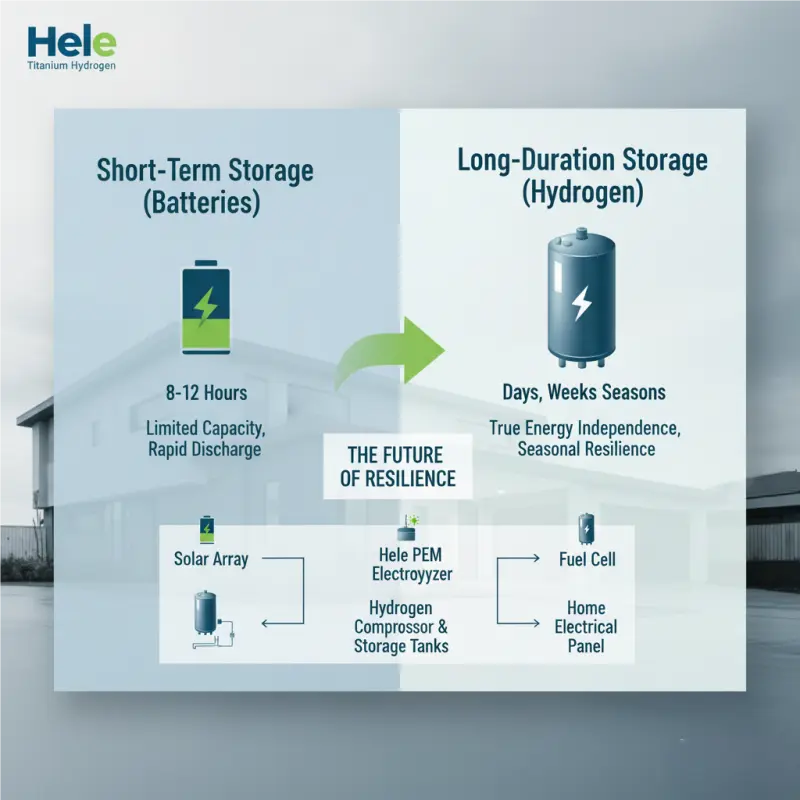
III. The Tangible Benefits of a Home Hydrogen System
Why make this investment? The benefits of a home hydrogen electrolyzer system extend far beyond a simple backup battery, offering a new level of energy resilience and sustainability.
Complete Energy Independence
This is the ultimate goal for many of our clients. A hydrogen energy system allows you to generate, store, and use your own energy entirely on your schedule. You become insulated from unpredictable utility price hikes, policy changes, and grid instability. During widespread blackouts, your home remains an island of power, running seamlessly.
Long-Duration, Seasonal Energy Storage
This is where hydrogen truly outshines batteries. A lithium-ion battery might power your home for 8-12 hours. What happens during a week-long storm or in the depths of winter when solar generation is low for weeks on end? Hydrogen allows you to store the massive energy surplus from the long, sunny days of summer and deploy it during the short, dark days of winter. This seasonal energy storage capability is something no residential battery can offer.
Customer Snapshot: A client in a rural, fire-prone region of California installed a Hele Hydrogen system alongside their 20kW solar array. During a recent Public Safety Power Shutoff that lasted five days, their property had full power. They ran their home, a refrigerated storage unit for their small farm, and their home office without interruption, while their neighbors relied on noisy, polluting diesel generators. For them, it wasn’t a luxury; it was critical infrastructure.
Ultimate Grid Backup & Resilience
Hydrogen provides robust, high-output power. Unlike some battery systems that struggle with high-draw appliances, a properly sized fuel cell can effortlessly run your air conditioning, water pumps, electric vehicle chargers, and workshop tools simultaneously. This makes it a far more reliable and capable backup power source.
A Truly Green, Zero-Emission Fuel Source
When your electrolyzer is powered by renewables, you are creating green hydrogen. The entire cycle—from creation to consumption—is free of carbon emissions. You are not only securing your own energy supply but also actively participating in the transition to a sustainable energy future.
Versatile Applications Beyond Electricity
Hydrogen is more than just stored electricity. The same system can be adapted for multiple uses:
- Heating: The heat generated as a byproduct of the fuel cell can be captured and used for domestic hot water or space heating, increasing overall system efficiency.
- Transportation: For owners of Fuel Cell Electric Vehicles (FCEVs), a home system can become your personal, zero-emission refueling station.
IV. Realistic Planning: Challenges & Expert Solutions
At Hele Hydrogen, we believe in transparency. Integrating a home hydrogen electrolyzer system is a significant engineering project with challenges that require expert planning. Here’s a realistic look at the considerations and how a professional approach mitigates them.
Upfront Investment & Electrolyzer Cost
There’s no hiding it: the initial capital outlay for a complete hydrogen system is substantial, often more than a solar and battery setup.
- Expert Solution: This should not be viewed as a simple appliance purchase but as a long-term infrastructure investment, much like drilling a well for water independence. The ROI isn’t just measured in payback from electricity bills, but in the invaluable assets of resilience, security, and complete energy independence. Furthermore, governments worldwide are rolling out significant tax credits and rebates for green hydrogen technologies. Our team can help you identify incentives in your region to significantly reduce the net electrolyzer cost.
Hydrogen Storage & Safety
Storing a flammable gas at high pressure rightfully raises safety questions. This is the most critical area for professional design and installation.
- Hele’s Approach: Safety is not an option; it’s the core of our design philosophy. Our systems are engineered with multiple layers of redundancy. Storage tanks are carbon-fiber-wrapped, pressure-tested vessels that have undergone gunfire and bonfire testing to prove their durability. The storage area is equipped with active ventilation and multiple hydrogen sensors. If a leak is ever detected—even at parts-per-million levels—the system will automatically shut down production, isolate the storage tanks, and alert you. We adhere strictly to international safety codes, ensuring every installation is vetted for compliance.
Round-Trip Efficiency
The process of converting electricity to hydrogen and back to electricity involves energy losses. This “round-trip efficiency” is typically in the range of 35-50%.
- Expert Solution: Critics often point to this figure without understanding the context. The alternative for massive surplus solar generation is often curtailment—meaning the solar inverter simply shuts down and wastes the energy. For long-duration storage, the value of hydrogen isn’t in its marginal efficiency but in its availability. Having 100% of the power you need in the middle of winter, sourced from summer sun, is infinitely better than having 0% power from a depleted battery. It solves a different problem than batteries do.
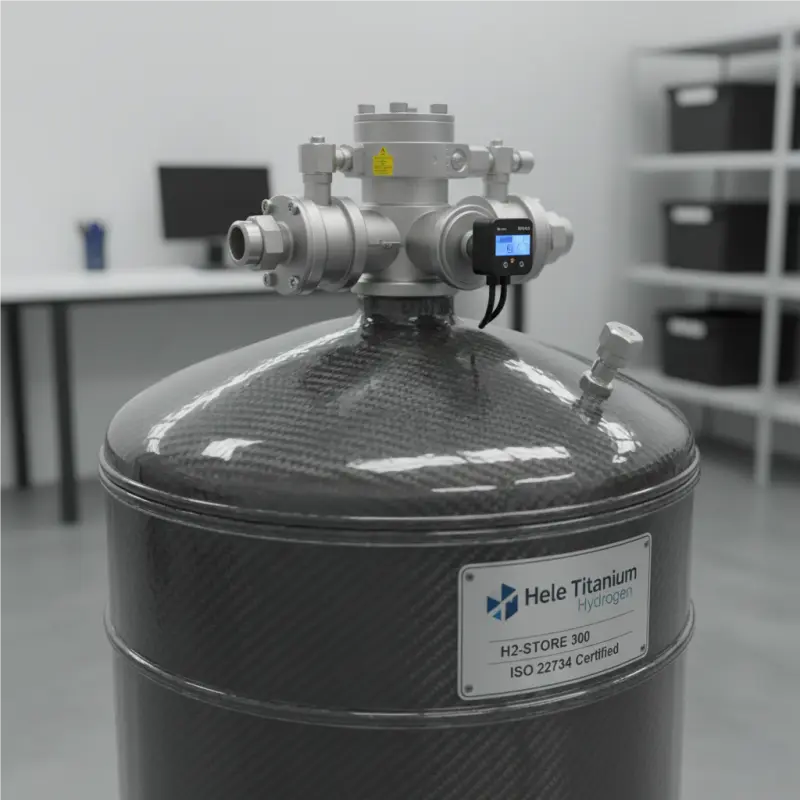
Permitting and Regulations
As a newer technology, navigating local building and fire codes for a home hydrogen installation can be complex.
- Hele’s Approach: We don’t just sell equipment; we provide solutions. We work exclusively through a network of certified installers who are trained on our systems and are experts in local permitting. They handle the entire process, from initial site assessment and engineering drawings to final inspection and commissioning, ensuring a smooth, compliant installation.
Ready to discuss the specific safety and integration requirements for your property? Schedule a free, no-obligation technical consultation with one of our engineers.
V. Financial Analysis: Calculating Your ROI
Is a home hydrogen electrolyzer system economically viable? The answer depends on several key factors. Let’s move beyond abstract concepts and look at a practical scenario.
Key Factors Influencing Your ROI:
- Cost of Utility Electricity: The higher your electricity rates (especially with Time-of-Use pricing), the faster your ROI.
- Net Metering Policies: In areas with poor net metering compensation, storing your excess solar as hydrogen becomes far more valuable than selling it back to the grid for pennies.
- Frequency of Power Outages: The cost of lost business, spoiled food, or running a diesel generator during outages adds up. What is the price of perfect reliability to you?
- Government Incentives: A 30% federal tax credit or a significant state-level rebate can dramatically shorten the payback period.
Sample ROI Scenario: The Self-Sufficient Homestead
- Location: A semi-rural property in a region with high electricity costs ($0.35/kWh peak) and frequent grid instability.
- System: 15kW solar array, Hele Hydrogen H2-Gen 5 (5 kg/day production), 50 kg hydrogen storage, 10kW fuel cell.
- Analysis:
- The system allows the homeowner to “time-shift” their solar production, avoiding buying any expensive peak power from the grid. Annual Savings: ~$4,500.
- During the year, they experience 5 full days of grid outages. A comparable diesel generator would cost ~$150/day in fuel and maintenance. Annual Savings: ~$750.
- The value of keeping a home-based business running without interruption during these outages is estimated at $2,000/year.
- A 30% federal tax credit on the total system cost reduces the initial investment significantly.
- The system allows the homeowner to “time-shift” their solar production, avoiding buying any expensive peak power from the grid. Annual Savings: ~$4,500.
- Conclusion: In this scenario, the tangible financial benefits provide a payback period of 12-15 years. However, the intangible value of total energy security, silence (no generator noise), and clean operation is realized from day one.
Want to calculate your specific ROI? We’ve developed a comprehensive worksheet that factors in your local utility rates, solar production, and available incentives. Download our free ROI Calculation Worksheet to get started.
VI. The Hele Hydrogen Difference: A Supplier Evaluation Checklist
When you are ready to invest in a home hydrogen electrolyzer system, choosing the right partner is as important as choosing the right technology. Not all systems are created equal. Use this checklist to ask the tough, technical questions that separate professional-grade suppliers from the rest.
- ✅ Technology & Core Components:
- Is the electrolyzer PEM or Alkaline? Ask them to justify why their choice is best for residential renewable integration.
- What materials are used in the electrolyzer stack and fittings? (Look for high-grade titanium and stainless steel for longevity).
- Is the electrolyzer PEM or Alkaline? Ask them to justify why their choice is best for residential renewable integration.
- ✅ Verified Performance & Purity:
- What is the nominal hydrogen production rate in kilograms per day or Nm³/hr?
- What is the guaranteed hydrogen purity level (e.g., 99.999%)? Request third-party validation.
- What is the system’s power consumption per kilogram of hydrogen produced (kWh/kg)? This is a key measure of efficiency.
- What is the nominal hydrogen production rate in kilograms per day or Nm³/hr?
- ✅ System Integration & Control:
- Does the system’s controller integrate with major solar inverter and energy management brands?
- How much control does the user have over production schedules and storage levels?
- Does the system’s controller integrate with major solar inverter and energy management brands?
- ✅ Safety Certifications & Compliance:
- Is the complete system certified to recognized standards (e.g., CE in Europe, UL in North America, ISO 22734 for hydrogen generators)? Ask to see the certification documents.
- Is the complete system certified to recognized standards (e.g., CE in Europe, UL in North America, ISO 22734 for hydrogen generators)? Ask to see the certification documents.
- ✅ Warranty, Support, and Maintenance:
- What is the warranty period on the PEM stack itself? (This is the most critical component).
- What does the recommended maintenance schedule look like?
- Do you offer remote monitoring and direct technical support from qualified engineers?
- What is the warranty period on the PEM stack itself? (This is the most critical component).
- ✅ Company Track Record & Expertise:
- How many years have you been manufacturing PEM electrolyzers?
- Can you provide technical case studies or connect me with a certified installer who has deployed your systems?
- How many years have you been manufacturing PEM electrolyzers?
At Hele titanium Hydrogen, we welcome these questions. We are proud of our engineering, our commitment to safety, and our track record of successful deployments. Request the detailed technical datasheet for our H2-Gen Residential Series to see our specifications for yourself.
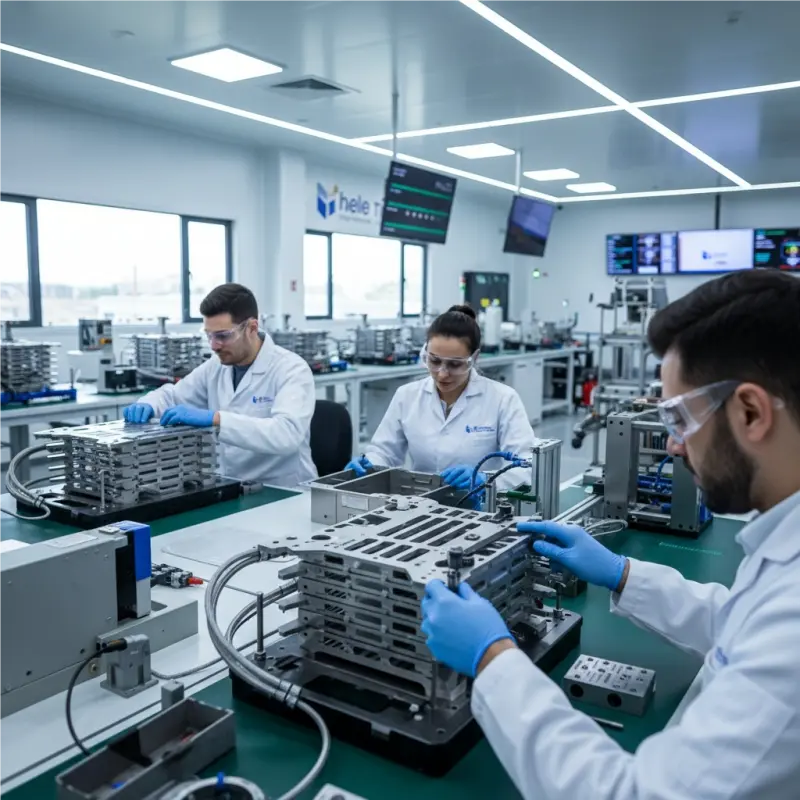
VII. System Integration: Connecting Hydrogen to Your Home
How does this equipment physically connect to your property? This practical step is where a skilled installer’s expertise is vital.
- Renewable Power Input: Your solar array feeds power to a hybrid inverter. The inverter powers your home’s immediate needs first.
- Diverting the Surplus: When the solar panels generate more power than the house is consuming (and any attached batteries are full), the smart Energy Management System (EMS) diverts this surplus DC power to the Hele titanium Hydrogen electrolyzer.
- Production & Storage: The electrolyzer uses this free, surplus energy to produce hydrogen, which is then compressed and stored in the tanks.
- Power on Demand: When solar power is unavailable and batteries are depleted, the EMS signals the fuel cell to start. It draws hydrogen from the tanks, generates AC electricity, and feeds it directly into your home’s main electrical panel, seamlessly powering all your circuits.
- Smart Control: The entire process is automated. You can monitor system status, storage levels, and energy flow from a smartphone app or web portal, giving you complete visibility and control over your energy assets.
VIII. Conclusion: Is a Home Hydrogen System Your Next Step?
A home hydrogen electrolyzer system is more than just the next gadget in renewable energy. It represents a fundamental shift in how we think about power. It’s a move from being a passive consumer to a proactive producer, a move from short-term battery backup to long-term, seasonal energy security.
Specifically, a system built on advanced PEM electrolyzer technology offers the responsiveness, compactness, and purity required for a truly efficient and reliable residential solution. While it demands a significant initial investment and meticulous planning, the rewards are unmatched: total freedom from the grid, absolute resilience against outages, and a genuinely zero-emission energy profile. This is the pinnacle of clean energy for your home.
The journey to energy independence is a technical one, and you don’t have to navigate it alone. If you’re ready to explore how a home hydrogen fuel system can fit into your long-term energy goals, our engineering team is here to provide the expert guidance you need.
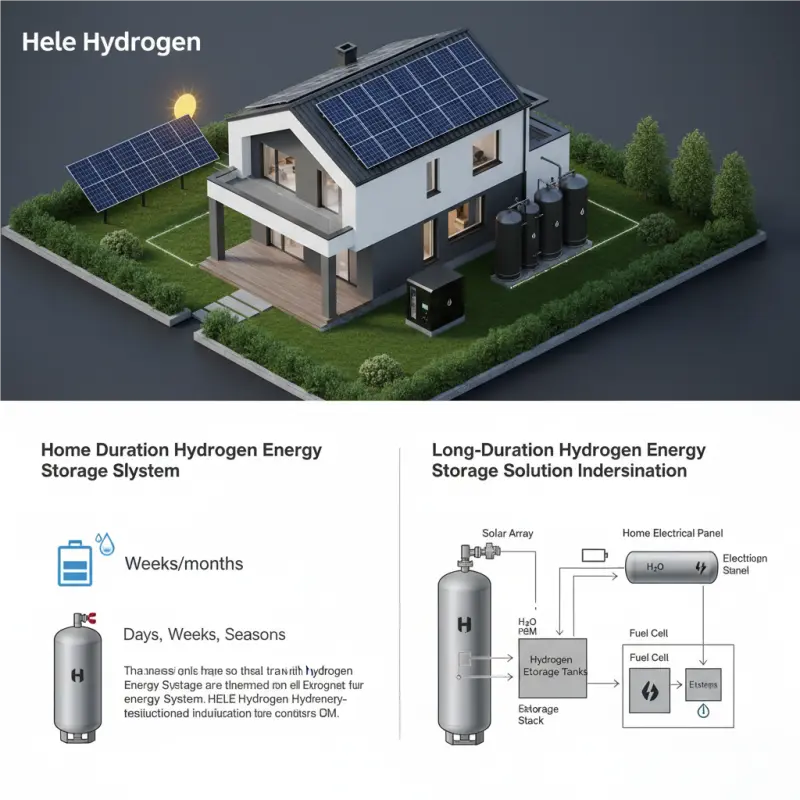
Take the next step:
- [Contact Us Today for a No-Obligation System Consultation]
- [Request the Detailed Spec Sheet for Our Residential PEM Electrolyzers]
Hele Titanium Hydrogen: Your Trusted Hydrogen Generator OEM & Manufacturing Partner
Hele Titanium Hydrogen stands as a reliable and experienced partner in the hydrogen generator OEM supply chain. We specialize in the design, development, and manufacturing of high-performance PEM Water Hydrogen Generators, offering comprehensive OEM & Manufacturing services tailored to your specific needs.
Take the Next Step
Ready to explore the possibilities of partnering with Hele Titanium Hydrogen?
- Browse our Products to see our range of PEM Water Hydrogen Generators.
- Learn more about our Services and how we can support your OEM & Manufacturing needs.
- Contact Us today to discuss your specific requirements.
- Explore our FAQ to get answers to common questions.
- Visit our Blog for the latest insights and updates on hydrogen technology.
Email Us: heletitaniumhydrogen@gmail.com
Phone/WhatsApp: 086-13857402537


